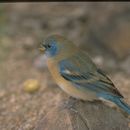en
names in breadcrumbs


Lazuli Buntings (Passerina amoena) are found over most of the United States and adjacent Canada west of the Great Plains. They breed in arid brushy areas in canyons, riparian thickets, chapparal, scrub oak, and open woodland. In summer in the western United States, they are common around thickets and streamside trees. In migration and in winter, they also occur in open grassy and weedy areas. The wintering range extends from southern Arizona and northern Mexico to southern Mexico.
Lazuli Buntings feed mainly on seeds and (especially in summer) insects (young are fed mostly insects). The nest is bult by the female in shrubs, vines, or low trees, typically around a meter above the ground. The female lays 3 to 5 (usually 4) eggs. At some nests, nestings are fed entirely by the female whereas at others the male assists. Young leave the nest around 10 to 12 days after hatching. If the female initiates a second clutch, males may take on a greater share of feeding the fledglings from the first clutch. Fall migration begins early, with many birds already moving by late July. Migrants stray east of the breeding range on the Great Plains, especially in spring.
Lazuli Buntings and Indigo Buntings (P. cyanea) are closely related species that hybridize where their breeding ranges overlap in the western Great Plains and eastern foothills of the Rocky Mountains of North America. Carling and Brumfield (2009) and Carling et al. (2010) reported on population genetic analyses to investigate the genetic architecture and dynamics underlying this interaction in the Great Plains. In addition to the range overlap in the Great Plains, since the mid-20th century, Indigo Buntings have extended their breeding range into New Mexico and Arizona, but their interactions with Lazuli Buntings here have not been as extensively studied as in the Great Plains. Lazuli and Indigo Bunting males defend territories against each other (behavior not typically seen between members of different species).
(AOU 1998; Kaufman 1996; Carling et al. 2010 and references therein)
The lazuli bunting (Passerina amoena) is a North American songbird named for the gemstone lapis lazuli.
Measurements:[2]
The male is easily recognized by its bright blue head and back (lighter than the closely related indigo bunting), its conspicuous white wingbars, and its light rusty breast and white belly. The color pattern may suggest the eastern and western bluebirds, but the smaller size (13–15 cm or 5–5.9 inches long), wingbars, and short and conical bunting bill quickly distinguish it. The female is brown, grayer above and warmer underneath, told from the female indigo bunting by two thin and pale wingbars and other plumage details.
The song is a high, rapid, strident warble, similar to that of the indigo bunting but longer and with less repetition.
Lazuli buntings breed mostly west of the 100th meridian from southern Canada to northern Texas, central New Mexico and Arizona, and southern California. On the Pacific coast their breeding range extends south to extreme northwestern Baja California. They migrate to southeastern Arizona and Mexico. Their habitat is brushy areas and sometimes weedy pastures, generally well-watered, and sometimes in towns.
They eat mostly seeds and insects. They may feed conspicuously on the ground or in bushes, but singing males are often very elusive in treetops.
It makes a loose cup nest of grasses and rootlets placed in a bush. It lays three or four pale blue eggs. In the eastern and southern part of its range, it often hybridizes with the indigo bunting.
The lazuli bunting (Passerina amoena) is a North American songbird named for the gemstone lapis lazuli.